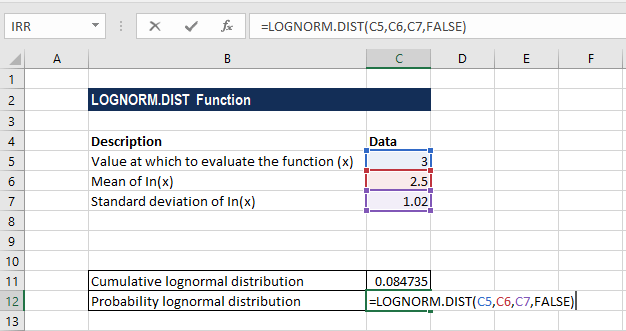

- Probability using mean and standard deviation excel how to#
- Probability using mean and standard deviation excel update#
You may use commas to separate input values instead of a colon if you prefer to list individual data points manually rather than providing Excel with the beginning and end cell markers for the dataset. Number2: For this input, select the cell containing the last data point from the sample population in your spreadsheet. Number1: For this input, select the cell containing the first data point from the sample population in your spreadsheet. Here's how you can fill in "Number1" and "Number2": The syntax of the Excel standard deviation formula using STDEV.S looks like this:
Probability using mean and standard deviation excel how to#
Related: Basic Excel Formulas and How To Use Them 2. If you need to calculate standard deviation for an entire population or want to include TRUE or FALSE values in your analysis, choose the standard deviation formula that most closely matches your needs. Most users can use STDEV.S to accomplish standard deviation calculations. STDEVP: This is an older version of the STDEV.P formula that still exists for compatibility. It still exists for compatibility purposes. STDEV: This is an older version of the STDEV.S formula that Excel used to calculate sample standard deviation before 2007. Like STDEVA, all FALSE valses are represented by 0, and TRUE values are represented by 1. STDEVPA: This formula calculates the standard deviation for an entire population and includes text and logical values in the calculation. All FALSE valses are represented by 0, and TRUE values are represented by 1. STDEVA: This formula calculates the sample standard deviation of a dataset and includes text and logical values in the calculation. It ignores text and logical values in the spreadsheet. STDEV.P: This formula calculates the standard deviation for an entire population based on numeric information alone. It ignores text and logical (TRUE or FALSE) values in the spreadsheet. STDEV.S: This formula calculates the sample standard deviation based on numeric information alone. If you type =STDEV into a blank cell in an Excel spreadsheet, six versions of the standard deviation formula appear. To calculate standard deviation in Excel, follow these steps: 1. Related: How To Calculate Standard Deviation: What It Is and How To Use It How to calculate standard deviation in Excel Other professionals who commonly use standard deviation include: This information may help these professionals make better educated financial predictions. Calculating standard deviation can reveal the volatility or stability of a market or investment opportunity. Professionals working in finance also often use standard deviation to analyze and manage investments and portfolios. Weather forecasters also commonly use standard deviation to explain the margin of error that the public can expect in their forecasts. For example, a marketer might calculate the standard deviation for money earned on an advertisement to better predict the range of revenues they might experience in the future. Many types of professionals use standard deviation to better understand the variance in particular datasets.


Read more: What Is Standard Deviation? How It Works and Other FAQs Uses for standard deviation This is a good way to streamline the data analysis process and keep track of data and statistical analysis in spreadsheets.
Probability using mean and standard deviation excel update#
If you change a data point in the spreadsheet, the function formula will automatically update to reflect the correct standard deviation for the new data. If your dataset already exists in an Excel spreadsheet, you can link it to the function formula to calculate for standard deviation without re-entering the data. This might be a time-consuming process to perform manually, but by using the formula function in Microsoft Excel, you can perform it quickly and efficiently. You can calculate standard deviation by taking the square root of the variance for a dataset.

A low standard deviation suggests that the data points are all closer to the average, while a high standard deviation suggests that the data points are spread over a wider range. Specifically, it shows whether numbers in a dataset are clustered together or spread out. Standard deviation can provide useful insight into the concentration of the data in a spreadsheet. Related: How To Include Excel Skills on Your Resume Why is standard deviation useful in spreadsheets? In this article, we explore the uses of standard deviation, explain how to use Excel to calculate standard deviation and provide an example. Microsoft Excel can calculate standard deviation in seconds, as long as you know which formulas and commands to use. This can be a very useful statistic for understanding how similar or dissimilar your data is. Standard deviation is the measurement of variation in a dataset.


 0 kommentar(er)
0 kommentar(er)
